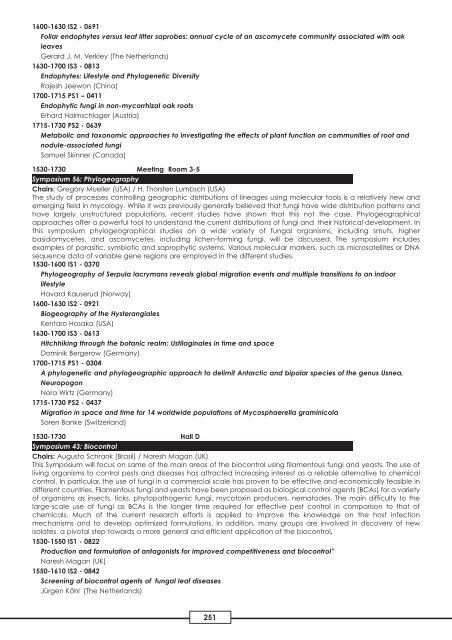Handbook Part 2 - International Mycological Association
Handbook Part 2 - International Mycological Association
Handbook Part 2 - International Mycological Association
You also want an ePaper? Increase the reach of your titles
YUMPU automatically turns print PDFs into web optimized ePapers that Google loves.
1600-1630 IS2 - 0691<br />
Foliar endophytes versus leaf litter saprobes: annual cycle of an ascomycete community associated with oak<br />
leaves<br />
Gerard J. M. Verkley (The Netherlands)<br />
1630-1700 IS3 - 0813<br />
Endophytes: Lifestyle and Phylogenetic Diversity<br />
Rajesh Jeewon (China)<br />
1700-1715 PS1 – 0411<br />
Endophytic fungi in non-mycorrhizal oak roots<br />
Erhard Halmschlager (Austria)<br />
1715-1730 PS2 - 0639<br />
Metabolic and taxonomic approaches to investigating the effects of plant function on communities of root and<br />
nodule-associated fungi<br />
Samuel Skinner (Canada)<br />
1530-1730 Meeting Room 3-5<br />
Symposium 56: Phylogeography<br />
Chairs: Gregory Mueller (USA) / H. Thorsten Lumbsch (USA)<br />
The study of processes controlling geographic distributions of lineages using molecular tools is a relatively new and<br />
emerging field in mycology. While it was previously generally believed that fungi have wide distribution patterns and<br />
have largely unstructured populations, recent studies have shown that this not the case. Phylogeographical<br />
approaches offer a powerful tool to understand the current distributions of fungi and their historical development. In<br />
this symposium phylogeographical studies on a wide variety of fungal organisms, including smuts, higher<br />
basidiomycetes, and ascomycetes, including lichen-forming fungi, will be discussed. The symposium includes<br />
examples of parasitic, symbiotic and saprophytic systems. Various molecular markers, such as microsatellites or DNA<br />
sequence data of variable gene regions are employed in the different studies.<br />
1530-1600 IS1 - 0370<br />
Phylogeography of Serpula lacrymans reveals global migration events and multiple transitions to an indoor<br />
lifestyle<br />
Havard Kauserud (Norway)<br />
1600-1630 IS2 - 0921<br />
Biogeography of the Hysterangiales<br />
Kentaro Hosaka (USA)<br />
1630-1700 IS3 - 0613<br />
Hitchhiking through the botanic realm: Ustilaginales in time and space<br />
Dominik Bergerow (Germany)<br />
1700-1715 PS1 - 0304<br />
A phylogenetic and phylogeographic approach to delimit Antarctic and bipolar species of the genus Usnea,<br />
Neuropogon<br />
Nora Wirtz (Germany)<br />
1715-1730 PS2 - 0437<br />
Migration in space and time for 14 worldwide populations of Mycosphaerella graminicola<br />
Soren Banke (Switzerland)<br />
1530-1730 Hall D<br />
Symposium 43: Biocontrol<br />
Chairs: Augusto Schrank (Brasil) / Naresh Magan (UK)<br />
This Symposium will focus on same of the main areas of the biocontrol using filamentous fungi and yeasts. The use of<br />
living organisms to control pests and diseases has attracted increasing interest as a reliable alternative to chemical<br />
control. In particular, the use of fungi in a commercial scale has proven to be effective and economically feasible in<br />
different countries. Filamentous fungi and yeasts have been proposed as biological control agents (BCAs) for a variety<br />
of organisms as insects, ticks, phytopathogenic fungi, mycotoxin producers, nematodes. The main difficulty to the<br />
large-scale use of fungi as BCAs is the longer time required for effective pest control in comparison to that of<br />
chemicals. Much of the current research efforts is applied to improve the knowledge on the host infection<br />
mechanisms and to develop optimized formulations. In addition, many groups are involved in discovery of new<br />
isolates, a pivotal step towards a more general and efficient application of the biocontrol.<br />
1530-1550 IS1 - 0822<br />
Production and formulation of antagonists for improved competitiveness and biocontrol”<br />
Naresh Magan (UK)<br />
1550-1610 IS2 - 0842<br />
Screening of biocontrol agents of fungal leaf diseases<br />
Jürgen Köhl (The Netherlands)<br />
251









